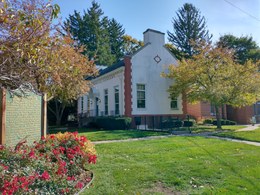Almont Library History
Almont is the sixth oldest village in the State of Michigan, founded in 1833 by Daniel Black when he purchased land for $1.25 an acre from the United States Government and built the first log house on Main Street. This document of purchase is on file in the collection. The first settlers of Lapeer County resided in Almont, therefore this area is full of historic interest and many visit the Almont District Library seeking information. The Village, which was originally called Newburg, was established in 1834. On January 5, 1846, the name of Almont was adopted in honor of a Mexican diplomat, Ambassador and General Juan V. Almonte. After the Civil War, the village of Almont boomed. Settlers from Ohio, New York, and Pennsylvania flocked into the township and county, securing the rich farm land from the territory at $1.25 an acre. The majority of the land purchase records are kept on file in the collection. Almont was an important community during the settlement of Lapeer and Sanilac Counties and to the lumber industry that was the foundation of the economy at the time. The railroad line that reached Almont starting in 1882 was a narrow gauge branch of the Port Huron and Northwest Railroad. The railroad was never extended and was abandoned in 1942. The first electric streetcar from Detroit reached Almont in 1914. The streetcar also brought electricity with it, as Almont was one of the first communities in the area to be served by electric power. The streetcar was later extended to Imlay City and served the community until 1925. Since 1909, the village of Almont has celebrated a Homecoming every five years. During Homecoming current and previous residents of the Almont congregate to celebrate the heritage and history of Almont. Many photographs and documents from these events are held in the collection of the Genealogical and Local History Room.
In 1916, Albert Stephens offered to fund the construction of a library in honor of his father, Henry Stephens, who was one of Almont’s earliest and most important settlers. The following year local contractor Al Thayer erected a Georgian Revival building, first opening to the public in 1919. Contents in the library were bought from gracious donations by the townspeople. In 1987, an addition was erected onto the building. The library is part of the West St. Clair Street National Register Historic District. The West St. Clair Street Historic District contains thirteen houses, two outbuildings, and the library. All of these buildings were added to the National Register of Historic Places by the U.S. Department of Interior on May 8, 1986. When word began to spread that the Village and the Township were going to merge and become a city, the Henry Stephens Memorial Library Board agreed to make the library a district library under Act 24 of the Michigan Public Acts of 1877. This agreement established that the district library would be a free public operating library in the Township, in the Village of Almont, and in Lapeer County, MI. On August 29th, 1994, the Henry Stephens Memorial Library became the Almont District Library.
On May 22, 1994, the library renamed the Genealogy Room the James P. Smith Genealogical and Local History Room in honor of Mr. Smith, who died in 1996 after fifty-three years as an Almont Library Board trustee. A member of the Almont High School graduating class of 1930, James P. Smith gave a great deal to his hometown. Besides his many civic involvements, he was also committed to the support of the Henry Stephens Memorial Library. He was first appointed to fill a Library Board vacancy in December 1943 and elected President of the Board in May 1944. Since that time, he guided the Library through fifty-two years of service to the people of Almont and surrounding communities, particularly in the fields of genealogy and historical research, until his death in 1996. Clearly the Henry Stephens Memorial Library would be a far different place without the personal commitment of Mr. James P. Smith. The Genealogical and Local History Room serves the local residents, as well as, the surrounding areas’ residents.
